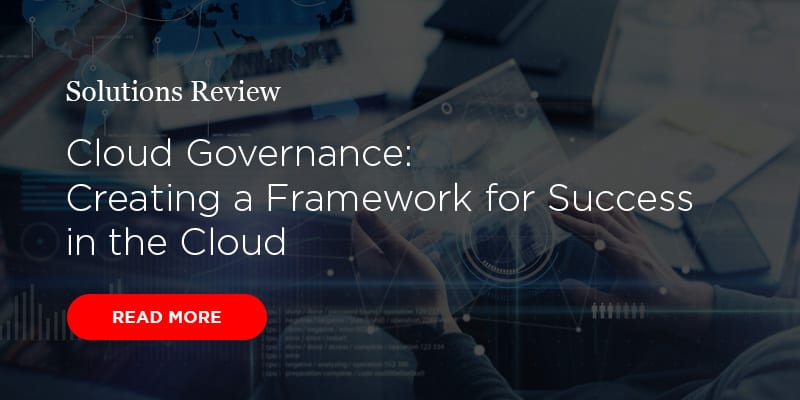Cloud Governance: Creating a Framework for Success in the Cloud

In order to operate a successful cloud deployment, your company needs a handful of tools and best practices in place. You need the right programs and systems to help you accomplish workflows in the cloud as well as make the migration process from on-premise to cloud (or vice versa) easier. You also need to enforce the correct policies to ensure that your workers are trained well enough to use the cloud effectively and safely. If you want to determine the right policies for your cloud operations, you need to implement a cloud governance framework.
While having the proper tools and software for your cloud environment is very important, enacting protocols that increase the efficiency of that cloud environment is essential for enterprises. Without those protocols, your company will be operating blindly in the cloud. That can lead to unexpected costs, unproductive workflows, or putting your data stored in the cloud at risk.
Creating a cloud governance framework (and maintaining it) allows your enterprise to cover all the bases when it comes to their cloud operations. Introducing policies for your cloud environment, confirming that they’re being followed, and updating them as needed establishes the groundwork for smooth cloud implementation. Below, we’ll explore the basics of cloud governance, how to create a governance framework that fits your business, and how enforcing your governance strategy will benefit your work in the cloud.
What is cloud governance?
Cloud governance refers to policies on using your cloud environment that your business adopts. The policies should be standardized across every area of your business so that every worker operates under the same principles. This prevents scenarios where two or more departments in your enterprise create or handle cloud-based data differently, causing compatibility issues. It also helps mitigate siloing, or instances where your departments deliberately keep their own information hidden from others to stop them from “interfering” with their work.
Governance isn’t concerned with the enforcement of these policies – that falls under the category of cloud management. Managing your cloud environment involves taking the policies that your governance framework establishes and creating solutions that keep in line with those policies. Both are essential parts of the process, as managing your governance framework allows you to see how well your policies are working. That knowledge tells you what protocols for your cloud environment you need to update.
Why should the cloud change my current governance strategy?
Your enterprise no doubt already has a governance framework in place for traditional IT problems. Thus, you may be asking the question: why would the cloud change anything? Why can’t I rely on my current governance framework to handle any problems with the cloud?
The problem is that traditional IT solutions are centralized tools designed specifically for use in particular departments. Traditional governance frameworks focus around approving the use of those tools as requested by workers. This approach works best for enterprises adoption solutions from various different vendors, but it isn’t suited for businesses that run a cloud environment.
The reason for that is simple: enterprise cloud operations are, by nature, decentralized. Business that implement the cloud take advantage of a multitude of cloud-native features. These features include services and solutions that span across various areas of business. That means that your company will be running its cloud environment across its entire infrastructure. A cloud governance framework allows your enterprise to create policies and standards that every worker in your enterprise, regardless of role or division, can follow. This gives each employee a common ground to stand on when working with the cloud.
What should your cloud governance strategy cover?
Depending on your business needs and desires for your cloud environment, your governance strategy will include a variety of different aspects. The basics of cloud governance include policies that optimize your cloud environment’s effectiveness on various levels. This could include resource usage, cost management, or security. A good rule of thumb is to understand what aspects of the cloud your enterprise might have trouble with. That will give you a foundation to start designing policies that address these problem areas.
Some of the most common issues that a cloud governance strategy can tackle are:
Cloud operations
Your enterprise needs to know exactly what workflows should be done in the cloud – and which ones shouldn’t. To ensure consistency across your enterprise, you should outline common tasks that you want to apply a cloud solution to. Then, you can inform your teams on that solution.
Cost efficiency
Cloud providers claim that using their cloud environment is more cost efficient for your business. This turns out to be true most of the time, but your enterprise needs to work to make its cloud operations cost efficient. Unnecessary cloud usage means that you’re wasting resources and money when an on-premise solution would work better.
Cloud security
Security remains one of the top issues that worry businesses adopting the cloud. Part of establishing a successful security plan is ensuring your workers don’t introduce security risks into the cloud environment. Your governance framework should include policies that inform your employees of practices that safeguard the cloud from security threats.
Performance monitoring
If you don’t have policies in place that examine how well your cloud environment is performing, your company can’t accurately judge where there’s room for improvement. Your cloud vendor may provide native monitoring tools or recommend you use third-party systems for it. Whatever the case, you can include policies on cloud performance to ensure that your performance baselines are being met.
How do you maintain your cloud governance framework?
Cloud governance is not a one-and-done thing. Once you establish the relevant policies, you need to evaluate whether or not they’re working further down the line. As your team becomes more comfortable with your cloud environment, they’ll have a better understanding of how to run it. Because of this, policies may change to reflect new knowledge or incorporate new cloud solutions. Your governance framework needs to adapt to these factors as they come up.
Your company won’t achieve successful cloud operation immediately. You’ll have to adjust your cloud strategy and policies as you move forward. Managing your cloud environment helps you understand how you need to adjust them. Cloud governance frameworks should be examined at various stages of the cloud adoption process, even years after the initial jump. If you aren’t modifying your framework to account for new processes and better cloud expertise, your company is likely to lose efficiency and productivity. Thus, your company needs to be flexible in how it governs your cloud operations.
Our MSP Buyer’s Guide contains profiles on the top cloud MSP vendors for AWS, Azure, and Google Cloud, as well as questions you should ask providers and yourself before buying. We also offer an MSP Vendor Map that outlines those vendors in a Venn diagram to make it easy for you to select potential providers.
Check us out on Twitter for the latest in Enterprise Cloud news and developments!


















